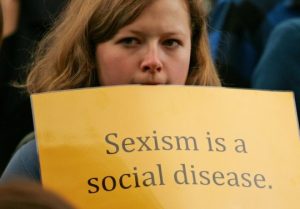The medical field is full of highly-skilled and demanding occupations that require strong mental health and acuity. Using social psychological concepts we can understand that this requirement for women, in a profession that’s predominantly made up of and tailored for men, needs extra strength and resilience. All newly-minted doctors have a significant amount of depression and anxiety due to the demanding and exhaustive work they do, but according to JAMA Internal Medicine it is far more difficult and present in women (Khullar).
Using social psychological concepts we can understand that this requirement for women, in a profession that’s predominantly made up of and tailored for men, needs extra strength and resilience. All newly-minted doctors have a significant amount of depression and anxiety due to the demanding and exhaustive work they do, but according to JAMA Internal Medicine it is far more difficult and present in women (Khullar).
One of the reasons behind this is that a woman, even though a medical professional, still shoulders the majority of household duties. Still fulfilling gender and societal norms women endure a work-home conflict that their male colleagues don’t experience. The medical field today promotes equal opportunity by law, but the institution, even though not driven by prejudices, exhibits sexism within the institutionalized practices that subordinate women (Myers, 254). Arguments for this is in the article by Dhruv Khullar. She states that little has changed in medical training procedures. Its reminiscent of days passed when almost all residents were men with few household duties. “Support for those trying to balance home and work life hasn’t kept pace with changing demographics, nor has the division of domestic labor shifted to reflect the rise of women in the medical work force. “(Khullar). The trend of accepting of women in the medical field has drastically changed, but unfortunately gender attitudes towards women have done little to support their personal lives which in turn affect their professional lives.
Our next reason and concept is implicit prejudices that usually occur automatically from preconceived notions about women. On many occasions in the article women are subjected as in-subordinates, not only by their male colleagues, but by patients alike. Women doctors who acknowledge their male counterparts formally don’t receive the same acknowledgement or aren’t called by their titles. Ev en women doctors who lead panels and studies with male counterparts are often referred to by their first name. Furthermore, women doctors in full medical assemble (white lab coat, professional attire, etc.) are called nurses or assumed to be medical assistants by patients. Another strong example of the implicit biases towards women was detailed by Heather Sarsons, Ph.D. who did a study to find out if surgeons’ gender affects their referrals after a good or bad patient outcome:
en women doctors who lead panels and studies with male counterparts are often referred to by their first name. Furthermore, women doctors in full medical assemble (white lab coat, professional attire, etc.) are called nurses or assumed to be medical assistants by patients. Another strong example of the implicit biases towards women was detailed by Heather Sarsons, Ph.D. who did a study to find out if surgeons’ gender affects their referrals after a good or bad patient outcome:
Ms. Sarsons finds that physicians are much less likely to refer patients to a female surgeon after a patient death, but barely change their referrals to a male surgeon. A bad experience with one female surgeon also makes physicians less likely to establish referral relationships with other female surgeons. There was no similar effect for men. (Khullar)
Not only does this show a prime example of implicit prejudices towards women but gives light to the fact that prejudices tend to over-generalize groups of people with stereotypes.
More than a third of medical physicians are women compared to just 7% of women back in the 1960s (Khullar). The opportunity in our time and day are abundant and encouraged for women, but the medical field was designed for men and remains implicitly and even possibly explicitly sexist towards women. We have to evaluate every action and policy to balance the odds, generate awareness, and create a supportive and enriching journey for women doctors everywhere. -FRANK JAMES CASILLAS III
Khullar, Dhruv. (2017, Dec 7). Being a Doctor Is Hard. It’s Harder for Women. New York Times. Retrieved from https://www.nytimes.com/2017/12/07/upshot/being-a-doctor-is-hard-its-harder-for-women.html
Myers, D. G. (2012). Exploring Social Psychology (Seventh Ed.). New York: McGraw-Hill.


